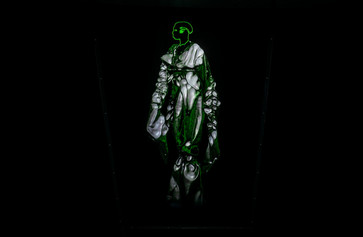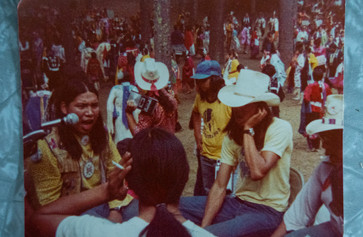
Rosa Barba’s Cinema of Transformation
How can a film hold time? The artist discusses her ongoing exploration of the medium’s physical and immaterial properties.
Rosa Barba, Erica Papernik-Shimizu
Jun 26, 2024
On view for the first time at MoMA, Rosa Barba’s film installation Aggregate States of Matters (2019) confronts the problem of how to visually address the complex subject of climate change, drawing from philosophical, spiritual, and cultural attitudes toward the changing landscape and time itself. I recently spoke with the artist about her conceptual approach to cinema, and how her specific use of its technology embodies the gravity and multilayered nature of environmental and cultural shifts.
—Erica Papernik-Shimizu, Associate Curator, Department of Media and Performance
To make Aggregate States of Matters, you worked closely with Indigenous communities in Peru, observing and documenting how daily rituals tied to the natural landscape have been impacted by the effects of a warming planet. In an earlier work from 2007, Outwardly from the Earth’s Center, you created a story about a society living on a piece of land in danger of disappearing. Can you speak about the ways in which ecological concerns are central to your practice as a filmmaker?
Transformation in landscapes, whether it originates from its complex history of global development and human interventions or due to ecological concerns such as climate change, have long been the starting points for my films. My work Outwardly from Earth’s Center centers on Gotska Sandön, a small island in Sweden that drifts north due to tidal currents, moving one meter away from the mainland every year. I constructed a narrative about how to tie the island to the sea; the act of anchoring the land to water transformed it from a mere object into a powerful idea. In the film, I begin with a specific subject and then explore the myriad possibilities that unfold from it. The narrative concludes with an aerial shot and hints at the idea of a potential solution. This work speculates on how the concept of documentation can evolve into a sculpture and reflect societal influences as an unintended consequence. There is a temporal element to a document or history, which we can observe or enter, and in my films, historical data is often transposed into a subjective voice-over or text layer. To quote Gilles Deleuze in his text Desert Islands, “Some islands drifted away from the continent, but the island is also that toward which one drifts; other islands originated in the ocean, but the island is also the origin, radical and absolute.”
For Aggregate States of Matters I worked with communities that are directly affected by the gradual, geological time of glacier melting becoming a present-day reality. In a cautious yet scrutinized exploration, the film illustrates blurring and melding boundaries between human and non-human actors. While some of the Indigenous populations that I worked with profit from the benefits and wealth of farming that rapidly increase due to changing environmental conditions, they concurrently face fast-moving challenges in their spiritual and cultural lives.
The title of your installation, Aggregate States of Matters, has many layers—having to do with geological time, climate change, and the very definition of tens of thousands of individual film frames. Could you tell us more about the title of this work?
I was thinking of a title that could describe a physical state of a landscape but also a collective experience that reflects different time layers from past to future—something that is at the same time a power unit but also liquid material; a psychological landscape in transformation and in a sort of magnetic field between its inhabitants.

Rosa Barba. Still from Outwardly from Earth’s Center. 2007

Rosa Barba. Aggregate States of Matters. 2019
I destabilize the old hierarchy of cinema’s various components by freeing them from their original uses and letting them interact in new and unforeseen ways.
Rosa Barba

Rosa Barba. Aggregate States of Matters. 2019
Part film and part sculpture, your work makes traditional filmmaking conventions a point of departure for something entirely new. Can you speak about this shift in context from cinema to museum gallery?
In my installations I explore film and its capacity to simultaneously be an immaterial medium that carries information and a physical material with sculptural properties. The category of film is expanded and abstracted beyond the literal components of the celluloid strip, the projector through which it passes, and the image projected onto a screen or beyond—where the landscape itself forms the screen. Each component becomes a starting point for artworks that expand on the idea of film while exploring its intrinsic attributes.
My work takes a conceptual approach that considers cinema in an architectural sense and as an instrument. The environment, the screen, and the projection are combined or pushed forward to create an entirely new spatiotemporal dimension. Uncertainty and speculation exist within that expanded space. It is an anarchic dimension and offers a new foundation for thinking and acting. I destabilize the old hierarchy of cinema’s various components by freeing them from their original uses and letting them interact in new and unforeseen ways.
By emphasizing the various parts of the film mechanism, your installation prompts the viewer to think about how information is transcribed, stored, transmitted, and perceived. This is relevant to the work’s consideration of the ways in which cultural knowledge is shared between generations of Indigenous communities. Notably, you made a point of avoiding voice-over narration in the film, eschewing the authority of a single voice. Instead, there are two moments where the image is completely overlaid with lines of text. Can you tell us more about this decision and what it means to you?
While preparing, but also shooting, Aggregate States of Matters, I interviewed many people from several Indigenous communities—including Quechua communities and the Uru-Iruito community, for example—as well as local archivists and geologists. With particular respect to the experiences of the Indigenous communities that were relayed to me, and which are shared orally throughout generations, I did not want to include them as voice-overs but to find a way for these stories to become part of the landscape as well, letting the voices appear as a visual transcription and at the same time inhabit the image. The text layers, builds up, and keeps moving, so that a linear reading is not really possible. I am always interested in finding ways to fragment language into forms where a non-chronological sense of time can be introduced to the viewer/reader.
The visible film grain and the flickering image help us to examine the possibility of activating a collective subconscious of a space outside of time, but marked by it.
Rosa Barba

Rosa Barba. Aggregate States of Matters. 2019

Rosa Barba. White Museum (Vassivière). 2010
Aggregate States of Matters contemplates a cyclical notion of time embraced by members of the communities seen in the film, which sits in contrast with the linearity more commonly associated with a Western approach. Viewed in the context of MoMA’s collection galleries, I’m prompted to think about yet another layer of time—“museum time”—and how institutions communicate historical narratives. Your 2010 work The Hidden Conference (2010–15) takes place in a museum, and your ongoing White Museum series turns museums into apertures, projecting light outward onto their exterior environments. Can you speak about the implications of positioning Aggregate States of Matters, specifically, at MoMA?
Yes, “museum time” embodies many dialogues throughout different time zones, as do museum spaces. We often remember previous exhibitions in the museum spaces we inhabit, and traces of previous exhibitions remain in the room. I was thinking while installing, and even before, how Aggregate States of Matters was in conversation with, for example, Sky Hopinka’s video meditation on time or also Sandra Mujinga’s hologram’s imagination in the darkness, both of which were on view at MoMA over the past two years. I see museum spaces as possibilities to continue conversations; every exhibition stays inscribed in the building’s memory. The Hidden Conference is a three-part film work exploring museum storage systems; the work’s title refers to imaginary conversations taking place between artworks inside these invisible spaces and between their creators, who often have not been contemporaries; nevertheless, their artworks can continue to speak through different generations.
Thinking about the tangible ways in which time is inscribed in nature—rings on a tree, melting glaciers—time is also inscribed in celluloid film: with each revolution through the projector it sustains scratches that are evidence of its life. And light itself, as Victoria Brooks wrote in her essay on your work, can be understood scientifically as distance traveled. For these reasons, film is elemental, firmly rooted in the natural world. You’ve spoken about the importance of the grainy image quality produced by the 35mm film stock you use. Can you share more about its significance to this work in particular?
It’s a sort of time-less image I am interested in creating. The visible film grain and the flickering image help us to examine the possibility of activating a collective subconscious of a space outside of time, but marked by it. This positions the viewer into an oscillating environment that is moving neither forward nor backward. And what we see when we watch the film—even the flicker—always appears different from when we recorded it.
There are parallels to be drawn between the increasing obsolescence of celluloid film and the climate crisis; to what extent are you interested in exploring this duality?
With film material as the most durable archival form, there is the wish and attempt to make nature live longer in some way, but at the same time both film and the natural landscape share this fragility, as well as organic, elliptical forms.

Rosa Barba. Still from The Hidden Conference: A Fractured Play. 2011
Rosa Barba’s Aggregate States of Matters is currently on view in MoMA’s second-floor collection galleries.
Related articles
-

Digital Ghosts and Shape-Shifting: Sandra Mujinga’s Flo
The artist shares the inspiration behind her larger-than-life hologram installation, now on view at MoMA.
Sandra Mujinga
Feb 27, 2023
-

Sky Hopinka: Film Is the Body
The artist reflects on how intergenerational suffering becomes a transgenerational reckoning, and how art can be a bridge.
Sky Hopinka
Jun 10, 2022

